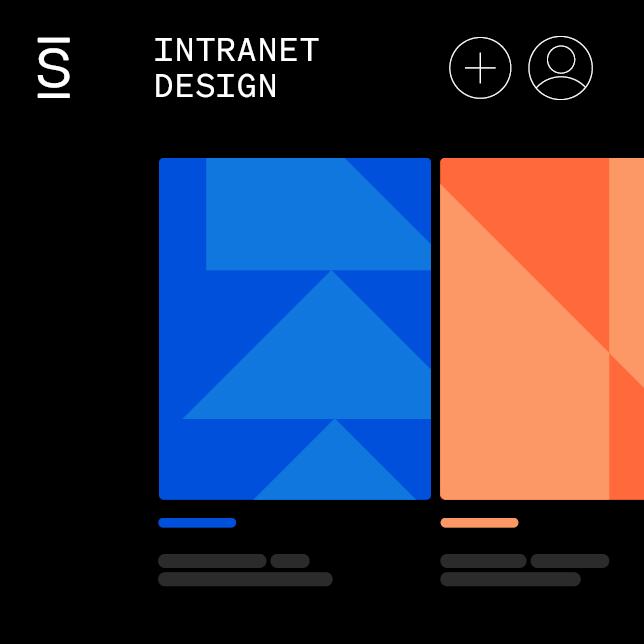As the modern Intranet finds a home in more and more companies, they are learning to leverage it to fit their unique organizational needs. Simpplr wants to encourage your business by sharing what you can accomplish to build organizational-wide collaboration, enhance your employees’ engagement, and create a company culture that is distinctive yet complementary to your work environment. However, before we share intranet examples of possibilities, let’s discuss what a modern Intranet is and what purpose it serves.
The Purpose of the Modern Intranet
Intranet technology has been around for over 25 years. The traditional intranet was created as a private network for internal communications within a company or learning institution. The desire for its use was that incorporating both hardware and procedures into business offices would produce efficiency, improve productivity, store vital company information, and lower overall costs.
Unfortunately, the original versions were not intra-connected. They also required significant IT interaction and were challenging to launch and maintain. Lastly, the user experience (UX) was cumbersome and not inviting. Costly maintenance and laborious need for content upkeep caused employees to leave the intranet portals searching for manual alternatives.
Today’s Modern Intranet is nowhere near the initial and rudimentary version. It is still used to store and access vital organizational information, but product designers and engineers watched and followed the success of the Internet, especially the rise of social media. By developing parallel looks and use, they found employees were attracted to its features and functions, thus improving engagement.
Organizations of all sizes found that with disparate and remote employees, some working worldwide, they needed a digital workplace that served as an efficient way to keep everyone informed. Beyond communication, the Intranet aids employees to integrate with digital productivity tools, connect with internal subject matter experts, and, of course, coworkers. Then, there is access to company information. No matter where the employee is, they can find up-to-date information on everything from HR policies to templates and documentation to accomplish their goals. It has become the virtual water cooler, where people can socially interact across departments and geographic regions.
New Intranets of the 2020s are purpose-built, incorporating use cases and perfected capabilities specific to various fields and industries. They continue to evolve, leveraging technological advances in cloud-based tools and connectivity, mobile apps User Experience (UX), and artificial intelligence, creating an employee experience that keeps them engaged. Now that you know what the modern Intranet offers, here are the standard core needs for every business or group.
Core Intranet Essentials
When companies acquire an intranet, it usually solves existing problems within their work environment. In the beginning, that was the intent of Sharepoint and Microsoft when they developed their intranet solutions. It centered on solving internal communication and collaboration issues. The modern Intranet has evolved, yet it still has the exact core requirements of removing silos while instilling ease of information access.
Related: SharePoint Alternative Options
While your company may be unique, existing in a particular field, the demands of an intranet may be expected and comprehensive. In particular, the needs are mostly centered around the employee. That was Simpplr’s founder and CEO, Dhiraj Sharma, intent—to create a work environment for employees that he too would want to be a part of. Our Intranet is meant to solve issues to enhance employee engagement, cultivate culture, and increase collaboration.
- Communication – The modern corporate Intranet has evolved into a digital informational hub purposefully built for all company or organization communication. Interestingly, the flow of communication can go in any way possible. Naturally, essential broadcasts from the C-suite and management can be sent out to all employees. It is filtered quickly and directed to teams, departments, and various organizations across the enterprise. Examples are changes in management or corporate-level positions, important company news, upcoming events, employee recognition or shout-outs, and changes in policies. That is only one direction. What about from the employee base and up?
Two-way comms are a must! Through surveys and forums, employees of all levels can let their voices be heard. Company communication can flow in many directions, from informing the company about desired work week changes to raising diversity concerns. Most of all, the Intranet enables and provides employee alignment and consistency in messaging. That prevents gaps in company knowledge and disbursement.
Another aspect of company communication that the Intranet is replacing is the cluttered email inbox. Everyone knows what it is like to look at the number of emails and feel completely overwhelmed. Because of the constant influx of emails employees have to sift through, the modern Intranet can be a digital workplace where the conversation takes center stage. Essential documents and deadlines won’t get lost, especially if your Intranet can be customized to meet the end-user specific needs.
- The Employee Voice – Your company intranet is a social intranet, giving rise to the employee voice. Through surveys and forums, employees of all levels can let their voices be heard. Company communication can flow in many directions, from informing the company about desired workweek changes to raising diversity concerns. Most of all, the company intranet enables and provides employee alignment and consistency in messaging. That prevents gaps in company knowledge and disbursement.
- Beyond the Email Inbox – Another aspect of company communication that the Intranet is replacing is the cluttered email inbox. Everyone knows what it is like to look at the number of emails and feel completely overwhelmed. Because of the constant influx of emails employees have to sift through, the modern Intranet can be a digital workplace where the conversation takes center stage. Essential documents and deadlines won’t get lost, especially if your Intranet design can be customized to meet the end-user specific needs.
- Cross-functional Collaboration – From the beginning of the Intranet’s creation, its primary purpose was to be a collaboration tool among employees, especially team members. Its functionality was to be a centralized source of information that enables workers to do their jobs to the best of their ability. With so many tools at their disposal, such as documents, case studies, templates, calendars with known deadlines and events, directory of contacts, and other shared information, the Intranet gives employees a place to collaborate and a sense of autonomy. They don’t have to run to management looking for the correct document. They can find things on their own. If they need to talk with a Subject Matter Expert, employees can utilize email, internal messaging systems, or other communication tools to access the right people in real-time.
- Central Deposit of Information or Source of Truth – In large enterprise companies or organizations, proprietary and discreet information can be lost amidst the many teams and departments, leaving employees who need access without its use. Document management would include procedural manuals, intellectual property, HR policies, and other sensitive documents. First, records of this nature need to be protected, so governance policies and protocols need to be put in place. Without them, intranets can easily fail. Second, having a central repository can increase productivity and efficiency by reducing time searching for records, templates, and the like. A company intranet can be effective for new hires trying to onboard and improve workflows with quick links to pertinent information that all employees may need. Lastly, having a central repository can increase productivity and efficiency by reducing time searching for records, templates, and the like.
- Ease of Use – Most companies haven’t realized the implication of having a simple intranet. The User Interface (UI) should be uncomplicated, instinctual, and easy to use. There is a mantra at Simpplr that says, “If employees need to be trained to use the intranet, you’ve already lost.” While the UI of your intranet is one of the most complex elements in design and development, it should be the most user-friendly piece. Without the ability to adapt to the intranet quickly, it won’t get used. Period. Begin with making your UI a part of the employee onboarding process. Incorporating it into the initial steps of a new hire can aid early adoption. Next, consider your disparate employees. By creating affinity sites for employees, they can connect on a topic of interest, and you increase the use of your intranet. These sites should resemble social media platforms. After all, most employees are already using them, and comfort equals ease of use. So, don’t be afraid of social features. Next, create sites for each department to manage their own content and make it purposeful (i.e., the top five most important documents). It gives employees and stakeholders a sense of departmental autonomy. While we are not encouraging internal competition, every team speaks their own language. Why not promote it? It will help employees engage.
- Internal Technical Support – Intranets has evolved into many things, including an IT support center to manage support calls. It can be challenging to address an equally large amount of tech support when you have a large enterprise with a significant employee population. It is no surprise that a company intranet has emerged as the leading way to handle considerable volumes of calls, requests, and, yes, emergency demands in a coordinated, organized, and safe manner.
With these desired and necessary core Intranet essentials, you may add other functions and tools to your platform to customize your intranet according to your needs depending on the business or industry requirements.
Intranet Examples for Your Digital Workplace
Now that you know the common needs in intranet usage, what kind of digital workspace do you want for your business and employees? No matter your industry, you want an intranet that engages them while providing all the necessary core essentials to make them a success. You also want it to contribute to building your company culture, including the message and mission. Lastly, do not forget that the Intranet must return to its fundamentals—communication and collaboration. At Simpplr, we understand this. That is why we want to share Intranet examples beyond tech Industries with you and show you what is possible for the non-tech world.
The Home Page-Your Exciting Invitation
The first item that should be focused on is your home page. No matter the business, every home page should set a theme and standard for your intranet. It should reflect your company’s theme and create an exciting invitation for all users to enter. Speaking of entry, do you have the proper security for appropriate login permissions. Your company intranet is for internal use only. Not only can permissions be set up by job level or title, department or office, or geographic location in the enterprise, it can limit access to what the employee only needs to see.
Utilizing your logo, brand, banners, and colors can visually appeal to a home page appearance and focus on tools and features. That also means consistency in the size of fonts and the use of white space. You don’t want a ‘busy’ home page that distracts employees from their intended purpose.
You want your homepage to be relevant with fresh content and quick links to help users find the information they want and need. And who are the contributors that create that content? Appropriate governance needs to be emphasized and enforced To ensure that information placed on your homepage is both current and valid. The last thing you want or need is stale content or inconsistent messaging.
While hyperlinks help users traverse your intranet to find needed documents, too many can overwhelm the user, and they get led away and lost. Keep them on a simple, consistent journey.
Authenticity is clearly vital to your home page. Try to incorporate company photos of your employees in their work situations and at corporate events. Be aware that too many videos can be demanding on your systems, wasting download time for graphics. Instead, utilize JPEGS and PNGS that translate remarkably well to your mobile apps.
By the way, do you have a mobile app? Consider applications and integrations that can be integrated into your intranet that help your remote employees use them on mobile devices. Where your employee goes, your intranet should go with them.
With your homepage description detailed, what should your intranet entail? Let’s look at various intranets for industries and the kind of experience you want for your employees.
The Healthcare Industry
Many guides begin with tech. However, right now, with the pressure of the COVID-19 pandemic, our healthcare sources are overrun. Sometimes, the best tool besides our healthcare providers’ healing hands and knowledge is their intranet tool.
There are substantial challenges to the healthcare employee experience. They are already enduring long hours and limited resources, not to mention stress and anxiety. How can your intranet platform mitigate those problems?
First, let’s concentrate on the diversity of employees and the complexity of their access needs to tech. Whether they are administrators, clinical doctors, staff, or members of the hospital community, everyone needs access to a communication system. There are several aspects to this demand.
- Emergency notifications
- Policy and procedure changes
- Emotional and communal connections
- Security and HIPPA compliance
In the article, The Impact of Digital Technology on Healthcare by HealthcareManagement.org, one of healthcare workers’ top three digital needs is improved lines of communication. Because the employee base is varied and broad, your tools into the intranet design should reflect that diversity. Think of including:
- Single-Sign-On (SSO) or Log in: Designing your intranet around commonly used or critical tasks is paramount to any healthcare provider. Why? Time-saving techniques and efficiency mean time spent with patients and high-demand areas. With an SSO, users can access other areas beyond the login page, such as HR or IT, thus creating a shorter duration with tasks and more time for a greater purpose.
- Easy Access to Intranet Content: Have you ever tried to find a document with a deadline looming? Now add the pressure of being a health care worker with a patient that can’t give you the detailed information you need to treat them. With clickable shortcuts or specific headings to guide users helps make the most use of their research time. Also, consider online education and the impact it has on your employees.
- Community and Staff Forums: Forums have two central importances. First, sharing knowledge with others to gain the fastest result for solving problems. Second, encourage co-workers who understand the common issues everyone is facing. No one understands what it is like to be a doctor, nurse, Physician’s Assistant, or any other healthcare worker but someone from their community. Airing concerns and posing questions in a safe and equal forum opens the door for workers to gain assistance when dealing with challenging issues.
- Surveys: Surveys can give insight into your workers’ feelings about their work environment or situation. Providing feedback allows the employer to create a feedback loop where things can be corrected. Such surveys can also be used by HR and providers to examine employees’ sentiment quickly. A brief view through a survey can detect an employee in need, providing an opportunity for a proactive response.
If there ever were a need to build community and culture in an organization, it would be within healthcare. With everything they face on the frontline of a pandemic, they deserve an intranet that gives them access to the right resources to serve them personally and professionally.
Subsection Intranets
When envisioning an Intranet, most think of a company-wide platform. But what about intranet sites built explicitly for teams, departments, or organizations? Two such examples would be HR or IT Support.
HR is a unique space. Every employee has to access HR—from onboarding to offboarding. But think of the time-saving ability if the individual user could access the appropriate forms and templates without having a human walk them through. New procedures and documents can be announced and amplified to the right employees or sectors of business. You can even create a FAQ page, where topics that employees often seek out have answers clearly explained. This type of self-serve action makes it efficient for HR and allows them to deal with issues of greater priority.
With IT Support, this is an excellent example of the cost and time-saving use of an Intranet. Rather than relying on a phone call or an email that has a possibility of being lost, IT requests can be handled through an IT Intranet. Because IT is constantly dealing with an influx of requests, your intranet can gauge the quality of the demand, escalate it as deemed necessary, and apply analytics to gather more user information. With insights into the end user’s ability or lack of understanding of company software, the IT team could refer them to in-app engagements, videos, or educational tools to help them not become repeat visitors. Once again, time and cost-saving through intranet use.
The Non-Information Technology Company
No one can deny the shift in digital transformation globally and its long-reaching implications. That means communication and connection are paramount in the digital age. But what if your company has nothing to do with tech? What if you are in an industrial services space, an upper education institution, or the hospitality industry? Having an intranet is just as crucial for these businesses and organizations as telecoms, finance, or real estate.
For industrial services, there are companies with a global workforce. That means plenty of project management issues. Begin with intranet features that encourage cross-collaboration, whether between teams or departments, across the enterprise, or globally. An intranet can help coordinate projects by separating them through different sites or tasks. With a central deposit of content, each project site can have its own source for plans, reports, budgets, metrics, and milestones. Supervising these functions and motions streamlines stabilizes workflows and promotes accountability, efficiency, and cost control. These important documents can be shared easily within the org or with outside vendors.
By highly coordinating procedures, things become streamlined, eliminating redundancy and miscommunication. Add in mobile capabilities, and field employees can coordinate schedules, calendars, and even inventory. Imagine how refined the relationship between sales and implementation can become with this type of collaboration. They can give dependable product pricing and availability information that keeps customers happy.
What Experience Do You Want to Give?
The modern Intranet has endless capabilities and functionality. When choosing and designing your organizational Intranet, think about your wants, needs, and, most of all, your end-user—the employee. You want your Intranet net users to be empowered by what they see, read, contribute, and take away. There is also the importance of flexibility in intranet software you choose. That not only applies to non-code integrations or additional workflows that extend to other systems. It applies to the human employee that needs to be mobile, agile, and not behind a desk. Request a demo and learn how modern Intranet, like Simpplr, can solve this for you.















